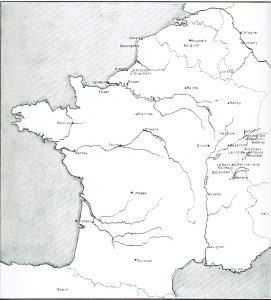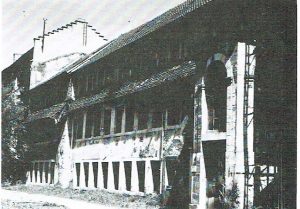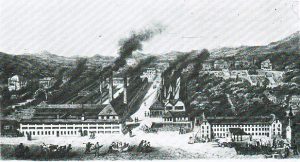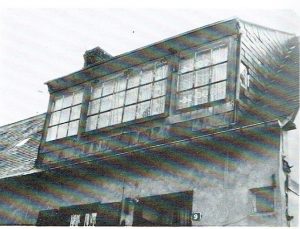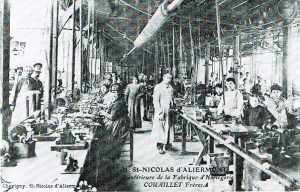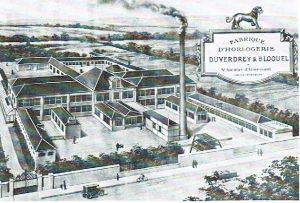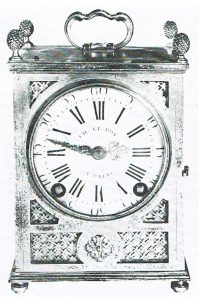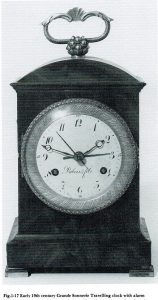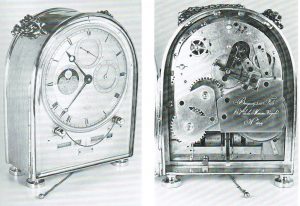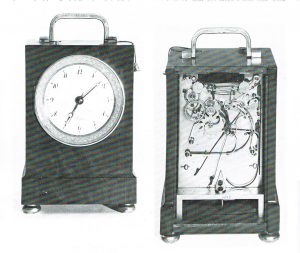The development of the French carriage clock.
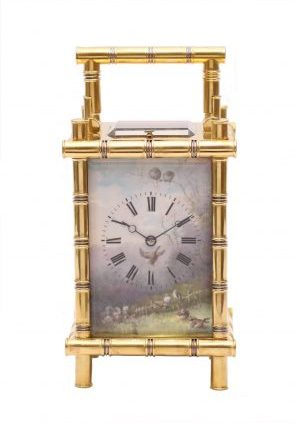
The clocks collection of Gude & Meis includes a wide range of carriage clocks. Therefore it seemed useful and fun to give a lecture on the development of these clocks. This article is the written version of this lecture which was held in September 2016 in our shop. I hope that you will enjoy reading about these clocks.
It is not possible to name all exeptions and nuances in a short article as this. But I do intend to explain the beginning and further development of the well known French carriage clock.
I have used the following books for reference and pictures, besides pictures of clocks that are ofr have been in the collection of Gude & Meis.
Charles Allix & Peter Bonnert, Carriage Clocks, their History and development, Woodbridge Engeland 1974.
Derek Roberts, Carriage and other Travelling Clocks, Atglen USA 1993.
Joseph Fanelli & Charles Terwilliger, A Century of fine Carriage Clocks, Bronxville USA, 1987.
The Production.
A clock is ususally made by several craftsmen. One can easily understand that a wooden or gilt bronze case wasn’t made by the clockmaker but another person. But we need to understand that already from the late 17thC on, there were specialists who made hands, dilas, springs and other parts of movements and so on. Partly this was done because specialists could produce better quality because they could produce better quality. But also the more crude work was done by lesser skilled (and cheaper) workmen.
Later in the 18th century whole movements were made by workers who worked from home or small workshops. The crude work of cutting and filing the plates was done but the whole was not polished. The arbours and wheels were in their place but needed polishing. But foremost these movements lacked their escapements and striking levers that needed to be made and adjusted by the skilled clockmaker. These unfinished movements were called ‘blanc roulants’ or ‘ebouches’. The clockmaker also needed to fit the dial work and hands.
Frederic Japy and the Jura.
Frederic Japy became master clockmaker in 1770. He lived and worked in the Jura near the Swiss border. He started out making these half finished movements for other clockmakers. He used craftsmen working from home to make parts for him. Soon he realized that by using machines he could speed up the crude work (like cutting and filing of the plates) and make it cheaper. He developed these machines and opened his first workshop in 1779 in Badeval.
 A few of his sons also opened large factories making clock movements for instance in Beaucourt. With this they laid the foundation for a large group of factories that existed up until the first World War.
A few of his sons also opened large factories making clock movements for instance in Beaucourt. With this they laid the foundation for a large group of factories that existed up until the first World War.
Here we see two pictures of the factory that was opened in 1810 in Badeval. The scale of the buildings is quite impressive to my opinion. The layout looks very efficient with all the windows for the workers.
There were other factories and workshops providing parts for these large factories themselves, like dials, escapaments etc. The still existing firm L’Epee provided platform escapements for carriage clocks.
St. Nicholas d’Alliermont.
 In the north west of France, the small town of St. Nicholas d’Alliermont became an important production centre for clock movements. There had been a clockmaking tradition for centuries but it had suffered greatly because of the Revolution and the Napoleontic wars. To provide jobs for the suffering local economy Paris was asked for help. It was Honoré Pons who was sent in 1806 to restart the industry. He first united the craftsmen in a sort of Guild. He then set up large workshops that produced movements in collaboration with craftsmen that worked from home. In this way he was able to set up a production of cheap well built movements. Typical for the houses of the workmen working from home are the windows with the small glass panes which are still visible in the town.
In the north west of France, the small town of St. Nicholas d’Alliermont became an important production centre for clock movements. There had been a clockmaking tradition for centuries but it had suffered greatly because of the Revolution and the Napoleontic wars. To provide jobs for the suffering local economy Paris was asked for help. It was Honoré Pons who was sent in 1806 to restart the industry. He first united the craftsmen in a sort of Guild. He then set up large workshops that produced movements in collaboration with craftsmen that worked from home. In this way he was able to set up a production of cheap well built movements. Typical for the houses of the workmen working from home are the windows with the small glass panes which are still visible in the town.
The Capucine
In the third quarter of the 18th Century in France there were clocks made for travel. There was a more luxurious type of clocks that we now call ‘Pendule d’officier’ and there was a more sober type that we call now ‘Capucine’. The term Pendule à la Capucine probably refers to the Capucine monks who lived very plainly. But there are also people say that the typical bell of the Capucines resembles the hood of the Capucine dress. Even though these clocks are less ornate than the ‘Pendules d’officier’, they were still too expensive for most people. One of the most telling differences between the pendules d’officier and Capucines is that the Capucines are hardly ever gilt.
The first generation of Capucines are individually shaped and differ per clockmaker. Before 1800 most Capucines have a pendulum that will not run of course when travelling. One needed to set up the clock at the place where one stayed.
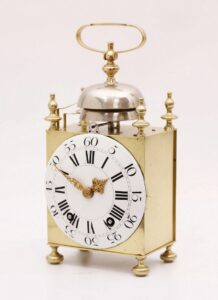 Our first example is a relatively large Capucine made by Bechet in Lyon. Looking at the style of the dial and hands, we can date this clock around 1770. The shape of the case is a clear example for the Capucines that would follow but it has a number of characteristics that are unusual. This fine clock has quarter striking and it lacks an alarm or repetition which would become standard for later clocks.
Our first example is a relatively large Capucine made by Bechet in Lyon. Looking at the style of the dial and hands, we can date this clock around 1770. The shape of the case is a clear example for the Capucines that would follow but it has a number of characteristics that are unusual. This fine clock has quarter striking and it lacks an alarm or repetition which would become standard for later clocks.
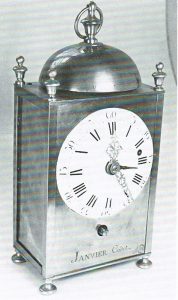 Here is another nice example of an early Capucine (circa 1780) made by Janvier Cadet who worked in the Jura. This clock doesn’t strike the hours but has alarm only. There is no bezel ( ornate ring around the dial ) which is an early characteristic. The austere appearance of this clock fits nicely with the term à la Capucine.
Here is another nice example of an early Capucine (circa 1780) made by Janvier Cadet who worked in the Jura. This clock doesn’t strike the hours but has alarm only. There is no bezel ( ornate ring around the dial ) which is an early characteristic. The austere appearance of this clock fits nicely with the term à la Capucine.
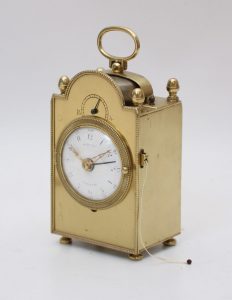 This clock is signed Bertrand A Paris and dates about 1790. It is well possible that this clock was made in the Jura but finished and sold in Paris by Bertrand. This clock also only has alarm and no striking work just like the Janvier clock. Again we can see that the earlier Capucines differ per maker and have their individual shape.
This clock is signed Bertrand A Paris and dates about 1790. It is well possible that this clock was made in the Jura but finished and sold in Paris by Bertrand. This clock also only has alarm and no striking work just like the Janvier clock. Again we can see that the earlier Capucines differ per maker and have their individual shape.
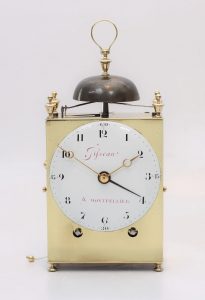 This lovely clock is signed Tisseau A Montpellier and also dates around 1790. It is very likely that this clock was made in the Jura and sold to Tisseau with its signed dial who was the re-seller. It is a fine example of a Capucine that has characteristics that would become more standard in the 19th Century. 1. The clock has half hour striking. It strikes once for the half hour and on the hour it strikes the full number of hours. It also repeats the hours after about two minutes. This is called Morbier striking and is very helpful because one often realizes too late that a clock is striking and is too late to count the strikes. With Morbier striking one only has to wait a few minutes to contiously count the strikes. 2. The clock will repeat the last hour on demand by either pulling a string or pushing a button. This feature is also very helpful since it was impossible to turn the light on quickly in the 18th Century, This way one could determine the time within the hour in the dark. 3. The clock has an alarm. It can be set by the steel pointer and activated by winding a small spring by pulling a cord. 4. The case has a number of characteristics that will become standard later on; doors to the back and sides, four urn finials on the corners and one on the bell support.
This lovely clock is signed Tisseau A Montpellier and also dates around 1790. It is very likely that this clock was made in the Jura and sold to Tisseau with its signed dial who was the re-seller. It is a fine example of a Capucine that has characteristics that would become more standard in the 19th Century. 1. The clock has half hour striking. It strikes once for the half hour and on the hour it strikes the full number of hours. It also repeats the hours after about two minutes. This is called Morbier striking and is very helpful because one often realizes too late that a clock is striking and is too late to count the strikes. With Morbier striking one only has to wait a few minutes to contiously count the strikes. 2. The clock will repeat the last hour on demand by either pulling a string or pushing a button. This feature is also very helpful since it was impossible to turn the light on quickly in the 18th Century, This way one could determine the time within the hour in the dark. 3. The clock has an alarm. It can be set by the steel pointer and activated by winding a small spring by pulling a cord. 4. The case has a number of characteristics that will become standard later on; doors to the back and sides, four urn finials on the corners and one on the bell support.
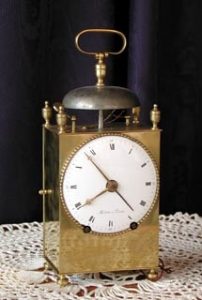 The clock shown here was made circa 1810. The Capucines dating from the 19th Century can be dated by their bezels. Initially they are thin. Later they will resemble the bezels of Empire mantel clock with engraved Acanthus leaves. At the end of the development around 1840 the bezels are wide and lack engraving.
The clock shown here was made circa 1810. The Capucines dating from the 19th Century can be dated by their bezels. Initially they are thin. Later they will resemble the bezels of Empire mantel clock with engraved Acanthus leaves. At the end of the development around 1840 the bezels are wide and lack engraving.
At the start of the 19th Century a more standarised production was developed in the Jura. This is easy to understand when we take the large production of movements in the region. In this way craftsmen could specialise in either dials, cases, etc. In this way the clocks could be produced more cheaply. We also see Capucines with cylinder escapement and balance from the start of the 19th Century which could keep on running when one was travelling. But besides these clocks with balance, clocks with pendulum were being produced.
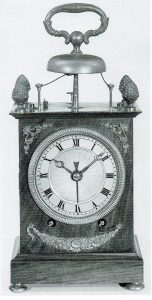 Besides brass cased Capucines, there were also Capucines made with wooden cases. Most stem from the second quarter of the 19th Century. Maybe these clocks with wooden cases were an attempt to ‘modernise’ these clocks a little bit and more attractive for potential buyers. Because when we look at the form of the Capucines, they are shaped like lantern clocks which have their origin in the 17th Century. Maybe the Capucines were very functional but also a little archaic. After 1840 the production of the Capucines diminishes quickly, which will be explained later on in this account.
Besides brass cased Capucines, there were also Capucines made with wooden cases. Most stem from the second quarter of the 19th Century. Maybe these clocks with wooden cases were an attempt to ‘modernise’ these clocks a little bit and more attractive for potential buyers. Because when we look at the form of the Capucines, they are shaped like lantern clocks which have their origin in the 17th Century. Maybe the Capucines were very functional but also a little archaic. After 1840 the production of the Capucines diminishes quickly, which will be explained later on in this account.
La pendule d’officier, the officer’s clock.
 As stated before there were the more luxurious clocks besides the Capucines called ‘pendule d’officier’, officer’s clock. The name obviously referring to the officer’s often of nobel descent who bought these clocks besides other rich clients. The development of these clocks runs partly paralel with the Capucines. Just as those clocks, the earlier officer’s clocks are individual per clockmaker and most of those are fitted with a pendulum. These clocks also had to be ste up at the place where one was staying.
As stated before there were the more luxurious clocks besides the Capucines called ‘pendule d’officier’, officer’s clock. The name obviously referring to the officer’s often of nobel descent who bought these clocks besides other rich clients. The development of these clocks runs partly paralel with the Capucines. Just as those clocks, the earlier officer’s clocks are individual per clockmaker and most of those are fitted with a pendulum. These clocks also had to be ste up at the place where one was staying.
The clock depicted here was made by J.B. du Tertre and is fitted with a finely engraved gilt bronze case with glass panels to the back and sides. It has striking work and alarm on a bell. The shaped of the finely foliate pierced and engraved hands together with the style of the dial indicate a date around 1770.
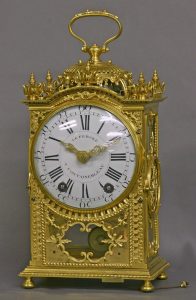 This is a third example of an early pendule d’officier and is signed Lefubere A Fontainebleau. The fine case is elaborately decorated and shows that appearance did sometimes won over functionality. Of course this clock was transported in a custom made wooden or leather case. This clock not only just has striking work but is also fitted with quarter repeating on demand. Again of course to hear what time it was in the dark.
This is a third example of an early pendule d’officier and is signed Lefubere A Fontainebleau. The fine case is elaborately decorated and shows that appearance did sometimes won over functionality. Of course this clock was transported in a custom made wooden or leather case. This clock not only just has striking work but is also fitted with quarter repeating on demand. Again of course to hear what time it was in the dark.
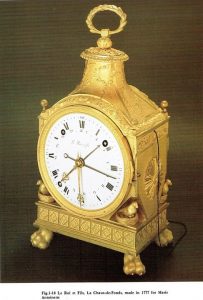 This fine clock was made in 1777 for Marie-Antoinette by LeRoi et Fils from La Chaux des Fonds in Switzerland near the French border. It has quarter striking and repetition, alarm and calendar. The case is well designed and finished with great detail. The arched case would become very populair with other makers.
This fine clock was made in 1777 for Marie-Antoinette by LeRoi et Fils from La Chaux des Fonds in Switzerland near the French border. It has quarter striking and repetition, alarm and calendar. The case is well designed and finished with great detail. The arched case would become very populair with other makers.
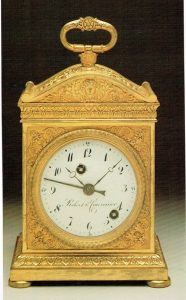 It was also in La Chaux des Fonds where some families specialised themselves in the production of pendukes d’officiers, like the Roberts and the Courvoisiers. The clock shown here is an example of their work. This somewhat standarised production is recognizable by their similarities and thus much less individual. These clocks, although slightly more common remained very expensive.
It was also in La Chaux des Fonds where some families specialised themselves in the production of pendukes d’officiers, like the Roberts and the Courvoisiers. The clock shown here is an example of their work. This somewhat standarised production is recognizable by their similarities and thus much less individual. These clocks, although slightly more common remained very expensive.
Often these clocks are fitted with striking work, repetition and alarm. It is not uncommon for these clocks to have quarter striking. A typcal characteristic is the striking work that is fitted to the backplate of the movement, which is a Swiss tradition. With French clocks we find the striking work fitted between the dial and frontplate.
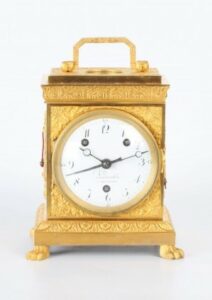 Here is another example of the production as described above made around 1800. This case has a flat top but the similarities with the above clock are obvious.
Here is another example of the production as described above made around 1800. This case has a flat top but the similarities with the above clock are obvious.
This clock is signed Vanderschen Bruxelles and is probably made including its dial (just like the capucine by Tisseau) in the region of La Chaux des Fonds for reseller Vanderschen. The three winding holes indicate that the clock has quarter striking, and it is further fitted with repetiton and alarm.
 Naast de productie in het oosten van Frankrijk en rond La Chaux des Fonds werden er ook Pendules d’officier gemaakt in Parijs. Vaak door goede makers en zeer exclusief en hierdoor veel individueler. Hier zien we een heel fraaie klok met kalenderwerk in heel fraaie vuurverguld bronzen kast gemaakt door Lepaute in 1823. Er bleef dus een zeer exclusieve productie bestaan voor de zeer gefortuneerden.
Naast de productie in het oosten van Frankrijk en rond La Chaux des Fonds werden er ook Pendules d’officier gemaakt in Parijs. Vaak door goede makers en zeer exclusief en hierdoor veel individueler. Hier zien we een heel fraaie klok met kalenderwerk in heel fraaie vuurverguld bronzen kast gemaakt door Lepaute in 1823. Er bleef dus een zeer exclusieve productie bestaan voor de zeer gefortuneerden.
Abraham Louis Breguet
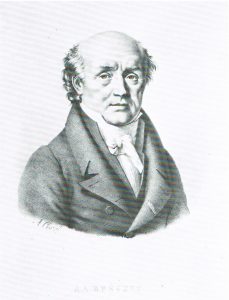 Abraham Louis Breguet is regarded by many as one of the greatest and most innovative clockmakers that ever lived. He was born in Neuchâtel Switzerland in 1747. His talent for clockmaker was discovered on a young age and he started working in Paris. Because of his talent and fine work he became the clockmaker of the Parisian elite and even Louis XVI. Also after the Revolution he soon became the leading clockmaker for the elite. He is responsible for many inventions and improvements in the horological field. Breguet died in 1823 but his firm was continued by his successors until modern times.
Abraham Louis Breguet is regarded by many as one of the greatest and most innovative clockmakers that ever lived. He was born in Neuchâtel Switzerland in 1747. His talent for clockmaker was discovered on a young age and he started working in Paris. Because of his talent and fine work he became the clockmaker of the Parisian elite and even Louis XVI. Also after the Revolution he soon became the leading clockmaker for the elite. He is responsible for many inventions and improvements in the horological field. Breguet died in 1823 but his firm was continued by his successors until modern times.
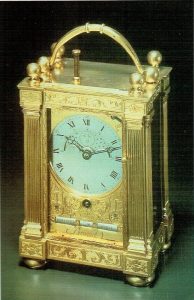 Breguet sold this Pendule d’officier to Napoleon Bonaparte in 1798 being one of a series of three. The clock has a balance (no pendulum), calendar, striking work and repetition. Both the movement and case are of the utmost quality and the clock was very expensive. With this clock Breguet introduced a type of pendule d’officier that would become iconic for him and his firm.
Breguet sold this Pendule d’officier to Napoleon Bonaparte in 1798 being one of a series of three. The clock has a balance (no pendulum), calendar, striking work and repetition. Both the movement and case are of the utmost quality and the clock was very expensive. With this clock Breguet introduced a type of pendule d’officier that would become iconic for him and his firm.
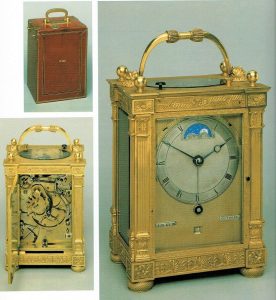 For my story on the typical French carriage clock that would be introduced later, the Empire case is important. Because with this design of glass panels to a rectangular case to all sides and the top, Breguet lays the foundation for the cases of the later French carriage clocks.
For my story on the typical French carriage clock that would be introduced later, the Empire case is important. Because with this design of glass panels to a rectangular case to all sides and the top, Breguet lays the foundation for the cases of the later French carriage clocks.
From the archives of the Breguet firm we know that this clock was sold for the sum of 4000 francs which was a small fortune in those days. In the second part I will also discuss prices of the carriage clock which even more will illustrate how large a sum of money this was.
We are now at the end of the first part of this article on the development of the French carriage clock. We can conclude that until circa 1830, there were travel clocks being made in France but not in great numbers. Of the ones that were made, the pendules d’officier were very expensive and affordable only for a few. The Capucines being cheaper but the design was out dated, looking like lantern clocks with their origins in the 17th Century.
part 2 will follow soon.

